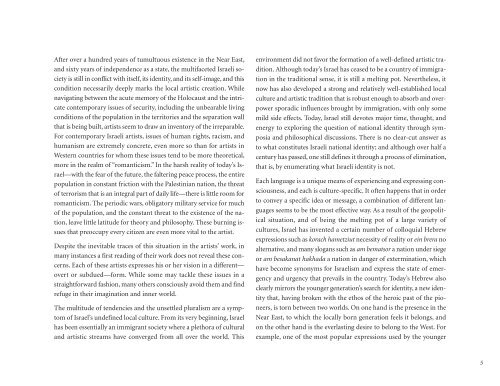Catalog of a Collection of Photographs by Gérard Allon in the Judaica Collection of the Harvard library
Create successful ePaper yourself
Turn your PDF publications into a flip-book with our unique Google optimized e-Paper software.
After over a hundred years <strong>of</strong> tumultuous existence <strong>in</strong> <strong>the</strong> Near East,<br />
and sixty years <strong>of</strong> <strong>in</strong>dependence as a state, <strong>the</strong> multifaceted Israeli society<br />
is still <strong>in</strong> conflict with itself, its identity, and its self-image, and this<br />
condition necessarily deeply marks <strong>the</strong> local artistic creation. While<br />
navigat<strong>in</strong>g between <strong>the</strong> acute memory <strong>of</strong> <strong>the</strong> Holocaust and <strong>the</strong> <strong>in</strong>tricate<br />
contemporary issues <strong>of</strong> security, <strong>in</strong>clud<strong>in</strong>g <strong>the</strong> unbearable liv<strong>in</strong>g<br />
conditions <strong>of</strong> <strong>the</strong> population <strong>in</strong> <strong>the</strong> territories and <strong>the</strong> separation wall<br />
that is be<strong>in</strong>g built, artists seem to draw an <strong>in</strong>ventory <strong>of</strong> <strong>the</strong> irreparable.<br />
For contemporary Israeli artists, issues <strong>of</strong> human rights, racism, and<br />
humanism are extremely concrete, even more so than for artists <strong>in</strong><br />
Western countries for whom <strong>the</strong>se issues tend to be more <strong>the</strong>oretical,<br />
more <strong>in</strong> <strong>the</strong> realm <strong>of</strong> “romanticism.” In <strong>the</strong> harsh reality <strong>of</strong> today’s Israel—with<br />
<strong>the</strong> fear <strong>of</strong> <strong>the</strong> future, <strong>the</strong> falter<strong>in</strong>g peace process, <strong>the</strong> entire<br />
population <strong>in</strong> constant friction with <strong>the</strong> Palest<strong>in</strong>ian nation, <strong>the</strong> threat<br />
<strong>of</strong> terrorism that is an <strong>in</strong>tegral part <strong>of</strong> daily life—<strong>the</strong>re is little room for<br />
romanticism. The periodic wars, obligatory military service for much<br />
<strong>of</strong> <strong>the</strong> population, and <strong>the</strong> constant threat to <strong>the</strong> existence <strong>of</strong> <strong>the</strong> nation,<br />
leave little latitude for <strong>the</strong>ory and philosophy. These burn<strong>in</strong>g issues<br />
that preoccupy every citizen are even more vital to <strong>the</strong> artist.<br />
Despite <strong>the</strong> <strong>in</strong>evitable traces <strong>of</strong> this situation <strong>in</strong> <strong>the</strong> artists’ work, <strong>in</strong><br />
many <strong>in</strong>stances a first read<strong>in</strong>g <strong>of</strong> <strong>the</strong>ir work does not reveal <strong>the</strong>se concerns.<br />
Each <strong>of</strong> <strong>the</strong>se artists expresses his or her vision <strong>in</strong> a different—<br />
overt or subdued—form. While some may tackle <strong>the</strong>se issues <strong>in</strong> a<br />
straightforward fashion, many o<strong>the</strong>rs consciously avoid <strong>the</strong>m and f<strong>in</strong>d<br />
refuge <strong>in</strong> <strong>the</strong>ir imag<strong>in</strong>ation and <strong>in</strong>ner world.<br />
The multitude <strong>of</strong> tendencies and <strong>the</strong> unsettled pluralism are a symptom<br />
<strong>of</strong> Israel’s undef<strong>in</strong>ed local culture. From its very beg<strong>in</strong>n<strong>in</strong>g, Israel<br />
has been essentially an immigrant society where a plethora <strong>of</strong> cultural<br />
and artistic streams have converged from all over <strong>the</strong> world. This<br />
environment did not favor <strong>the</strong> formation <strong>of</strong> a well-def<strong>in</strong>ed artistic tradition.<br />
Although today’s Israel has ceased to be a country <strong>of</strong> immigration<br />
<strong>in</strong> <strong>the</strong> traditional sense, it is still a melt<strong>in</strong>g pot. Never<strong>the</strong>less, it<br />
now has also developed a strong and relatively well-established local<br />
culture and artistic tradition that is robust enough to absorb and overpower<br />
sporadic <strong>in</strong>fluences brought <strong>by</strong> immigration, with only some<br />
mild side effects. Today, Israel still devotes major time, thought, and<br />
energy to explor<strong>in</strong>g <strong>the</strong> question <strong>of</strong> national identity through symposia<br />
and philosophical discussions. There is no clear-cut answer as<br />
to what constitutes Israeli national identity; and although over half a<br />
century has passed, one still def<strong>in</strong>es it through a process <strong>of</strong> elim<strong>in</strong>ation,<br />
that is, <strong>by</strong> enumerat<strong>in</strong>g what Israeli identity is not.<br />
Each language is a unique means <strong>of</strong> experienc<strong>in</strong>g and express<strong>in</strong>g consciousness,<br />
and each is culture-specific. It <strong>of</strong>ten happens that <strong>in</strong> order<br />
to convey a specific idea or message, a comb<strong>in</strong>ation <strong>of</strong> different languages<br />
seems to be <strong>the</strong> most effective way. As a result <strong>of</strong> <strong>the</strong> geopolitical<br />
situation, and <strong>of</strong> be<strong>in</strong>g <strong>the</strong> melt<strong>in</strong>g pot <strong>of</strong> a large variety <strong>of</strong><br />
cultures, Israel has <strong>in</strong>vented a certa<strong>in</strong> number <strong>of</strong> colloquial Hebrew<br />
expressions such as korach hametziut necessity <strong>of</strong> reality or e<strong>in</strong> brera no<br />
alternative, and many slogans such as am bematsor a nation under siege<br />
or am besakanat hakhada a nation <strong>in</strong> danger <strong>of</strong> exterm<strong>in</strong>ation, which<br />
have become synonyms for Israelism and express <strong>the</strong> state <strong>of</strong> emergency<br />
and urgency that prevails <strong>in</strong> <strong>the</strong> country. Today’s Hebrew also<br />
clearly mirrors <strong>the</strong> younger generation’s search for identity, a new identity<br />
that, hav<strong>in</strong>g broken with <strong>the</strong> ethos <strong>of</strong> <strong>the</strong> heroic past <strong>of</strong> <strong>the</strong> pioneers,<br />
is torn between two worlds. On one hand is <strong>the</strong> presence <strong>in</strong> <strong>the</strong><br />
Near East, to which <strong>the</strong> locally born generation feels it belongs, and<br />
on <strong>the</strong> o<strong>the</strong>r hand is <strong>the</strong> everlast<strong>in</strong>g desire to belong to <strong>the</strong> West. For<br />
example, one <strong>of</strong> <strong>the</strong> most popular expressions used <strong>by</strong> <strong>the</strong> younger<br />
5


